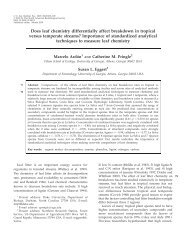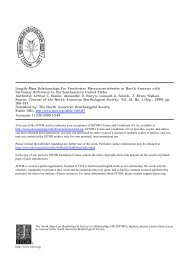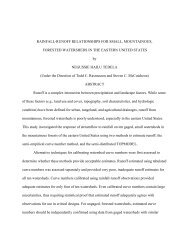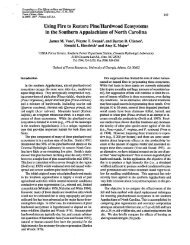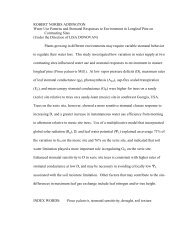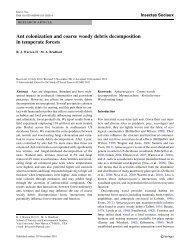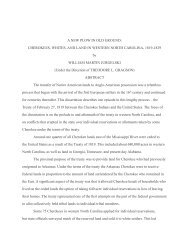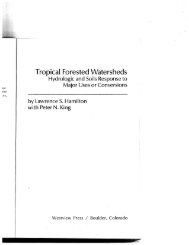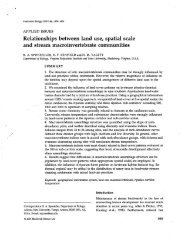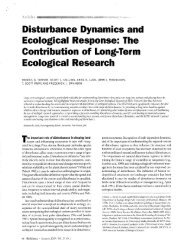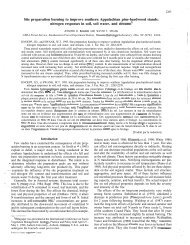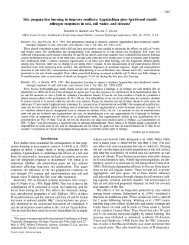biology join - Coweeta LTER - University of Georgia
biology join - Coweeta LTER - University of Georgia
biology join - Coweeta LTER - University of Georgia
Create successful ePaper yourself
Turn your PDF publications into a flip-book with our unique Google optimized e-Paper software.
Articles<br />
land in the region from 36.8% in 1993 to 45.1% in 2010<br />
(Golodetz and Foster 1997). Research on the potential for<br />
local constraints on forestry to displace harvesting pressures<br />
to other, more sensitive parts <strong>of</strong> the world has broadened<br />
public acceptance <strong>of</strong> forestry in the region (Berlik et al. 2002).<br />
Surveys have documented how underrepresented old-growth<br />
forests are in southern New England, which has aided in the<br />
preservation <strong>of</strong> the few remaining sites (Orwig et al. 2001,<br />
D’Amato et al. 2006). Many <strong>of</strong> these linkages grew out <strong>of</strong><br />
strong informal ties between scientists and stakeholders built<br />
by serving on local, state, and regional committees.<br />
In 2005, the Harvard Forest launched its Wildlands and<br />
Woodlands (W&W) Initiative, which emphasizes decisionrelevant<br />
synthesis, communication, and stakeholder partnerships.<br />
The knowledge gained from dozens <strong>of</strong> studies at<br />
the Harvard Forest was synthesized into a series <strong>of</strong> W&W<br />
publications that were aimed at nonscientists and that called<br />
for stemming the loss <strong>of</strong> forest cover now occurring in all<br />
six New England states as large areas (e.g., in Maine) experience<br />
significant shifts in landownership. The publications<br />
call for balancing the preservation <strong>of</strong> wildlands with large<br />
areas <strong>of</strong> actively managed woodlands and for promoting<br />
civic engagement through landowner-conceived woodland<br />
councils (Foster et al. 2005, 2010).<br />
Since 2005, the W&W Initiative has produced two major<br />
reports, two update publications, and a Web site (www.<br />
wildlandsandwoodlands.org), with the purpose <strong>of</strong> raising<br />
awareness about the pace and consequences <strong>of</strong> land-cover<br />
change. Both W&W reports had extensive stakeholder input,<br />
and the second garnered comments from several hundred<br />
agency, nongovernmental-organization (NGO), landowner,<br />
and industry representatives. Harvard Forest has since<br />
teamed up with the nonpr<strong>of</strong>it organization Highstead to<br />
form a partnership with more than 60 participating groups<br />
to sustain stakeholder engagement and to help implement<br />
the vision <strong>of</strong> the W&W Initiative. The reports were accompanied<br />
by press releases; webinars; stakeholder briefings;<br />
and, in May 2010, a public event with Harvard <strong>University</strong>’s<br />
Kennedy School <strong>of</strong> Government.<br />
Assessing the societal impact <strong>of</strong> Harvard Forest research<br />
over the past 100 years is beyond the scope <strong>of</strong> this case<br />
study. However, we compiled information on the impact<br />
<strong>of</strong> W&W communication to shed light on the value <strong>of</strong> this<br />
coordinated outreach effort. In the two months following<br />
its release, the 2010 report generated 137 media and<br />
newsletter stories and 62 visits per day to the new W&W<br />
Web site, including visitors from 35 countries from five<br />
continents. By contrast, Harvard Forest garnered 21 non-<br />
W&W news stories between 2008 and 2010. W&W authors<br />
participated in 21 briefings, presentations, and workshops<br />
in the nine months since publication, which expanded the<br />
project’s influence and reach. These W&W synthesis and<br />
communication efforts have contributed to several notable<br />
policy and management advances, including the decision by<br />
the state <strong>of</strong> Massachusetts to establish permanent wildland<br />
reserves, the introduction <strong>of</strong> a conservation-finance bill in<br />
the Massachusetts General Assembly to accelerate the pace<br />
<strong>of</strong> conservation, and the launching <strong>of</strong> an innovative effort<br />
to aggregate multiple parcels into a single project with the<br />
goal <strong>of</strong> conserving approximately 10,000 acres <strong>of</strong> forest in<br />
western Massachusetts. The W&W efforts also fueled new<br />
research, including the establishment <strong>of</strong> new long-term<br />
study plots across sites with diverse histories, ownership, and<br />
management objectives; and a new cross-site <strong>LTER</strong> proposal<br />
on the Future Scenarios <strong>of</strong> Forest Change (see Thompson<br />
et al. 2012 [in this issue]).<br />
Sustained research–management partnerships at the Andrews<br />
Forest <strong>LTER</strong> site. The H. J. Andrews Experimental Forest and<br />
<strong>LTER</strong> site in the Oregon Cascade Range contains many <strong>of</strong><br />
the iconic and hotly debated elements <strong>of</strong> Pacific Northwest<br />
forests: old-growth trees; northern spotted owls; and cold,<br />
clear, fast streams. Societal conflicts over the future <strong>of</strong> the<br />
vast tracts <strong>of</strong> federal forestlands in the region have been<br />
pr<strong>of</strong>oundly affected by science findings from the Andrews<br />
Forest and, in turn, have strongly influenced the course <strong>of</strong><br />
science in the region and more broadly.<br />
The research history <strong>of</strong> the Andrews Forest, stretching<br />
back to its establishment in 1948, reflects a commitment<br />
to long-term ecological and watershed research by the US<br />
Forest Service and with NSF-funded programs under the<br />
International Biological Program in the 1970s, followed by<br />
<strong>LTER</strong> Network since 1980. These integrated science programs<br />
have produced high-quality studies and long-term<br />
records that underpin interpretations <strong>of</strong> ecosystem and<br />
environmental change and sustain an interdisciplinary cadre<br />
<strong>of</strong> scientists, all <strong>of</strong> whom are essential in investigating ecosystems<br />
that change abruptly and also gradually over time<br />
scales <strong>of</strong> decades and centuries. The context <strong>of</strong> extensive<br />
federal forestlands (e.g., US Forest Service, US Bureau <strong>of</strong><br />
Land Management) provides an audience <strong>of</strong> land managers<br />
who are required to guide management using current<br />
science. And, if they fail to do so, litigants and the courts<br />
remind them.<br />
A central feature <strong>of</strong> the Andrews Forest program is a<br />
research–management partnership that develops, tests, demonstrates,<br />
and critically evaluates alternative approaches to<br />
management so that when the policy window opens, new,<br />
scientifically and operationally credible approaches to management<br />
are ripe for broad adoption (http:// andrewsforest.<br />
oregonstate.edu/resmgt.cfm?topnav=35). This partnership<br />
involves the research community centered on the Andrews<br />
Forest <strong>LTER</strong> site and land managers <strong>of</strong> the Willamette<br />
National Forest. The partnership has made substantial<br />
impacts on forest management and policy on topics such<br />
as the characteristics <strong>of</strong> and conservation strategies for oldgrowth<br />
forest ecosystems (Franklin et al. 1981, Spies and<br />
Duncan 2009); the ecological roles and management implications<br />
<strong>of</strong> dead wood on land and in streams (Gregory et al.<br />
1991); the ecology and population dynamics <strong>of</strong> the northern<br />
spotted owl (Forsman et al. 1984); the effects <strong>of</strong> forest cutting<br />
and roads on streamflow, including floods (Jones 2000);<br />
358 BioScience • April 2012 / Vol. 62 No. 4 www.biosciencemag.org



